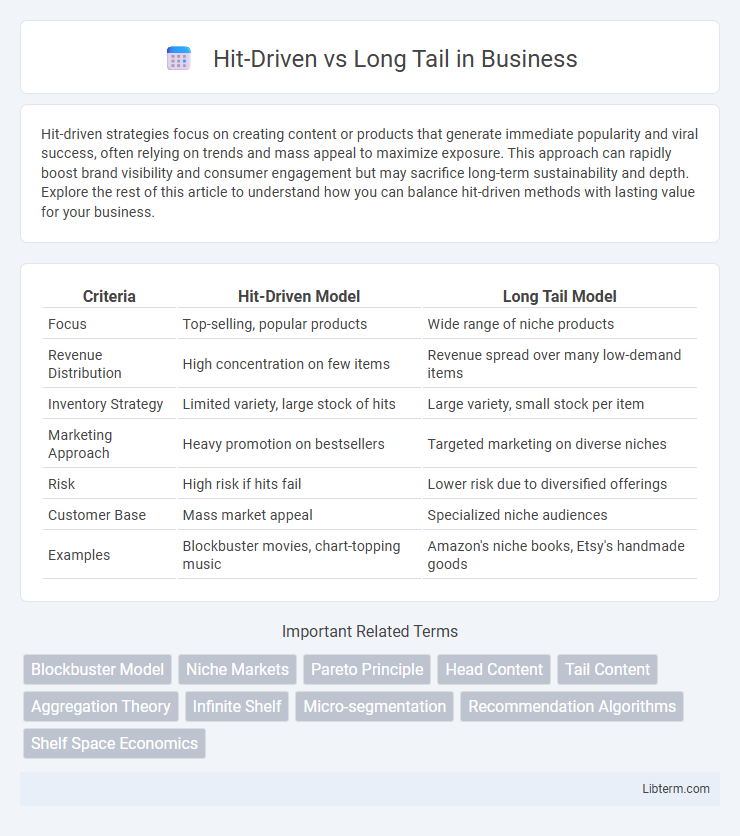Hit-driven strategies focus on creating content or products that generate immediate popularity and viral success, often relying on trends and mass appeal to maximize exposure. This approach can rapidly boost brand visibility and consumer engagement but may sacrifice long-term sustainability and depth. Explore the rest of this article to understand how you can balance hit-driven methods with lasting value for your business.
Table of Comparison
| Criteria | Hit-Driven Model | Long Tail Model |
|---|---|---|
| Focus | Top-selling, popular products | Wide range of niche products |
| Revenue Distribution | High concentration on few items | Revenue spread over many low-demand items |
| Inventory Strategy | Limited variety, large stock of hits | Large variety, small stock per item |
| Marketing Approach | Heavy promotion on bestsellers | Targeted marketing on diverse niches |
| Risk | High risk if hits fail | Lower risk due to diversified offerings |
| Customer Base | Mass market appeal | Specialized niche audiences |
| Examples | Blockbuster movies, chart-topping music | Amazon's niche books, Etsy's handmade goods |
Understanding the Hit-Driven Model
The hit-driven model focuses on producing and promoting a small number of highly popular products or content that capture the majority of consumer attention and revenue. This approach leverages concentrated marketing efforts, large investment in blockbuster projects, and data analytics to identify potential hits early. It contrasts with the long tail model, which targets a wide variety of niche products with lower individual demand but collectively generate significant sales.
Exploring the Long Tail Concept
The Long Tail concept emphasizes targeting niche markets with specialized products that individually have low demand but collectively generate substantial revenue. Unlike Hit-Driven strategies focusing on mainstream blockbusters, Long Tail leverages digital distribution and search algorithms to connect consumers with diverse, less popular items. This approach maximizes market reach by capitalizing on aggregated sales of numerous unique offerings rather than relying on a few high-selling hits.
Key Differences Between Hit-Driven and Long Tail Strategies
Hit-driven strategies focus on generating high revenue from a small number of popular products or content with mass appeal, while long tail strategies emphasize selling a large variety of niche items in smaller quantities, leveraging cumulative demand. Hit-driven models rely on major hits to drive market dominance and quick returns, whereas long tail approaches prioritize sustained revenue streams through extensive catalogs and diverse consumer preferences. Data analysis in hit-driven strategies centers on identifying potential blockbusters, contrasting with long tail tactics that optimize catalog breadth and discoverability.
Market Dynamics: Hits vs. Niches
Market dynamics in hit-driven models prioritize blockbuster products that achieve massive popularity and generate significant revenue quickly, often dominating mainstream consumer attention. In contrast, long tail strategies focus on diverse, niche markets where numerous specialized products collectively create substantial value by catering to specific, less saturated customer segments. This approach leverages digital distribution and data analytics to efficiently target and serve fragmented consumer preferences, maximizing overall market reach.
Consumer Behavior in Hit-Driven and Long Tail Markets
Consumer behavior in hit-driven markets centers on mainstream preferences, where blockbuster products capture mass attention and drive significant sales through high visibility and widespread marketing. In contrast, long tail markets reflect niche consumer interests, with purchasing patterns spread across diverse, less-popular items that collectively generate substantial market value. The shift towards digital platforms has empowered consumers to explore personalized, specialized content, reinforcing the economic power of long tail markets alongside traditional hit-driven dynamics.
Revenue Models: Peaks vs. Persistence
Hit-driven revenue models generate significant income from a few high-performing products or services, often leading to sharp sales peaks and short-lived dominance in the market. Long tail revenue models capitalize on a vast array of niche offerings, resulting in steady and persistent income streams over time due to cumulative smaller sales. Businesses leveraging long tail strategies often benefit from diversified revenue sources and reduced reliance on blockbuster hits for sustainable profitability.
Content Creation and Distribution Approaches
Hit-driven content creation prioritizes high-impact, viral topics designed to capture mass attention quickly through trending keywords and popular themes, maximizing short-term engagement across major platforms like YouTube and Instagram. Long tail strategies focus on niche, evergreen content aimed at specific audiences, leveraging targeted SEO and specialized distribution channels to maintain consistent traffic and sustained relevance over time. Combining both approaches optimizes reach by balancing immediate viral potential with steady, long-term audience growth.
Case Studies: Hit-Driven Successes and Long Tail Triumphs
Hit-driven successes like Netflix's original series "Stranger Things" demonstrate how blockbuster content generates massive viewership and subscriber growth through concentrated popularity. Long tail triumphs are evident in platforms such as Amazon, where a vast inventory of niche products collectively contributes substantial revenue over time. Case studies reveal that combining hit-driven strategies with long tail offerings maximizes overall market reach and profitability.
Challenges and Risks of Each Model
Hit-driven models face challenges including high dependency on a few blockbuster products, which can lead to significant revenue volatility and increased pressure on marketing and production to deliver continuous hits. Long tail models risk dilution of brand identity and higher operational costs due to managing a vast array of niche products, potentially resulting in lower average profitability per item. Both strategies require careful inventory management and consumer demand forecasting to mitigate risks associated with stockouts or overproduction.
The Future of Content: Hit-Driven, Long Tail, or Hybrid?
The future of content distribution hinges on a hybrid model that merges the scalability of hit-driven strategies with the personalized reach of the long tail. Hit-driven content leverages blockbuster appeal, often dominating market share through mass popularity and extensive media exposure, while long tail content capitalizes on niche audiences by providing diverse, specialized options that accumulate substantial total engagement. Combining data analytics and AI-driven recommendations enables platforms to optimize revenue streams by balancing broad hits and targeted long-tail content, capturing both mass audiences and fragmented niche markets.
Hit-Driven Infographic

 libterm.com
libterm.com